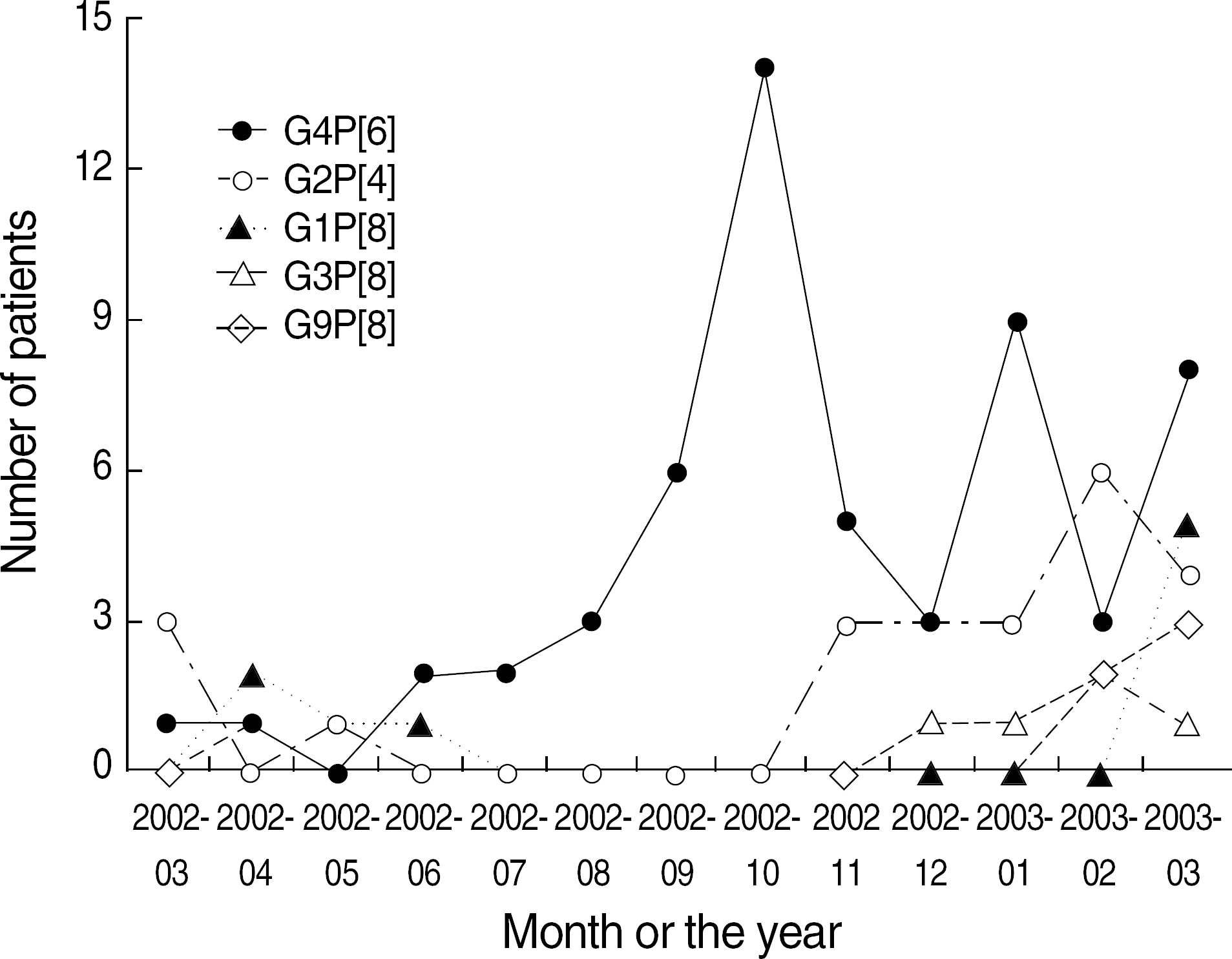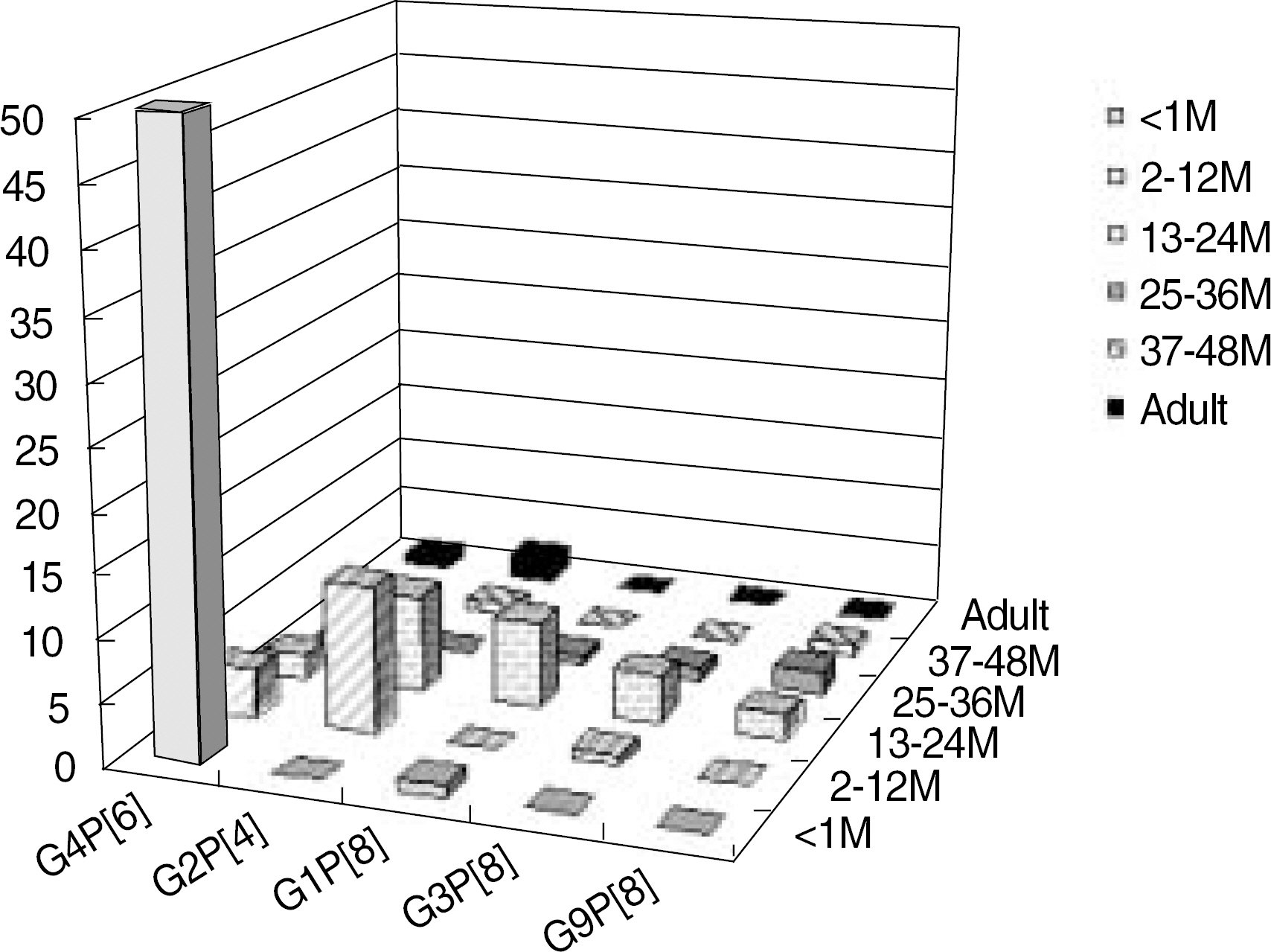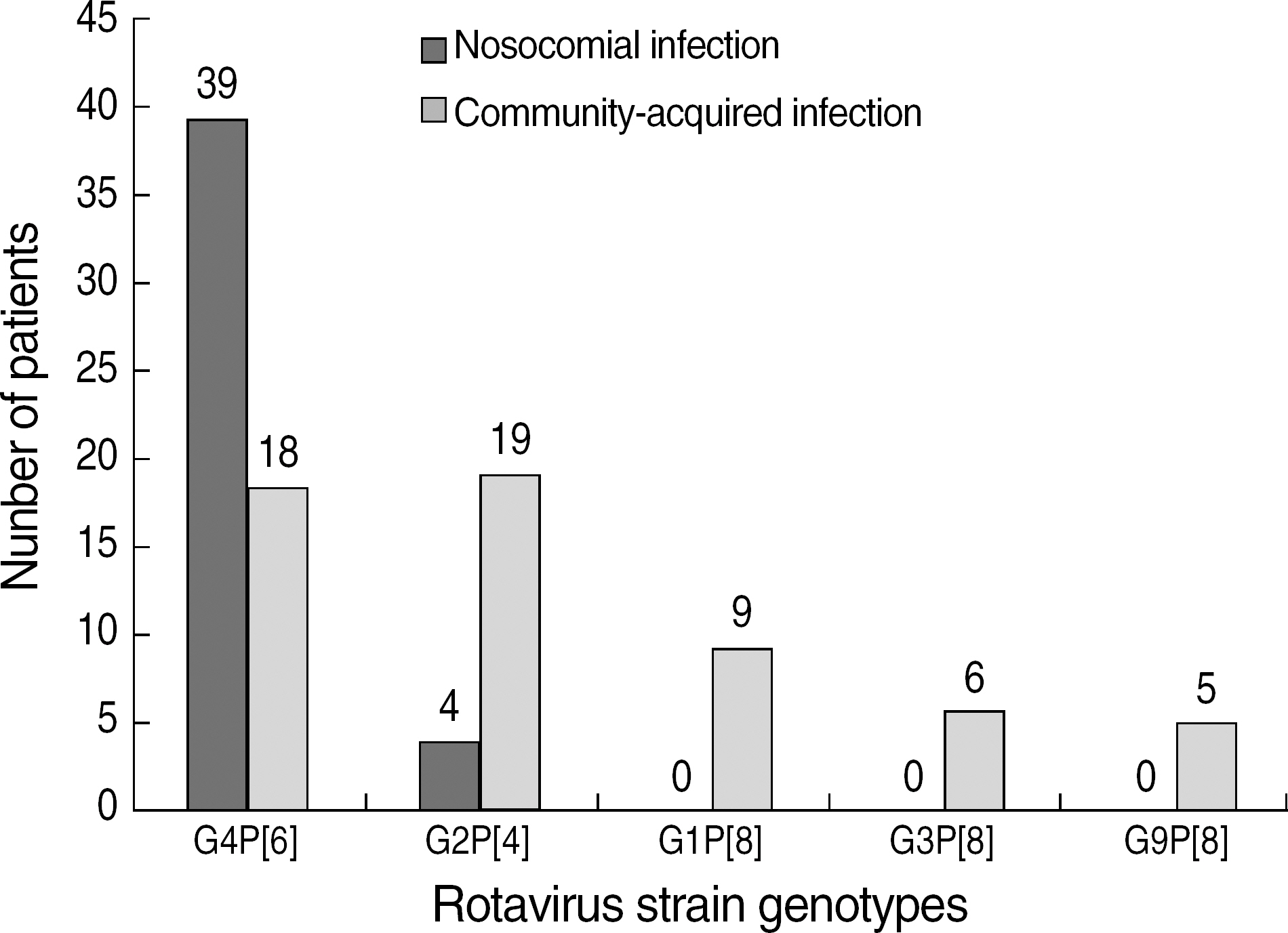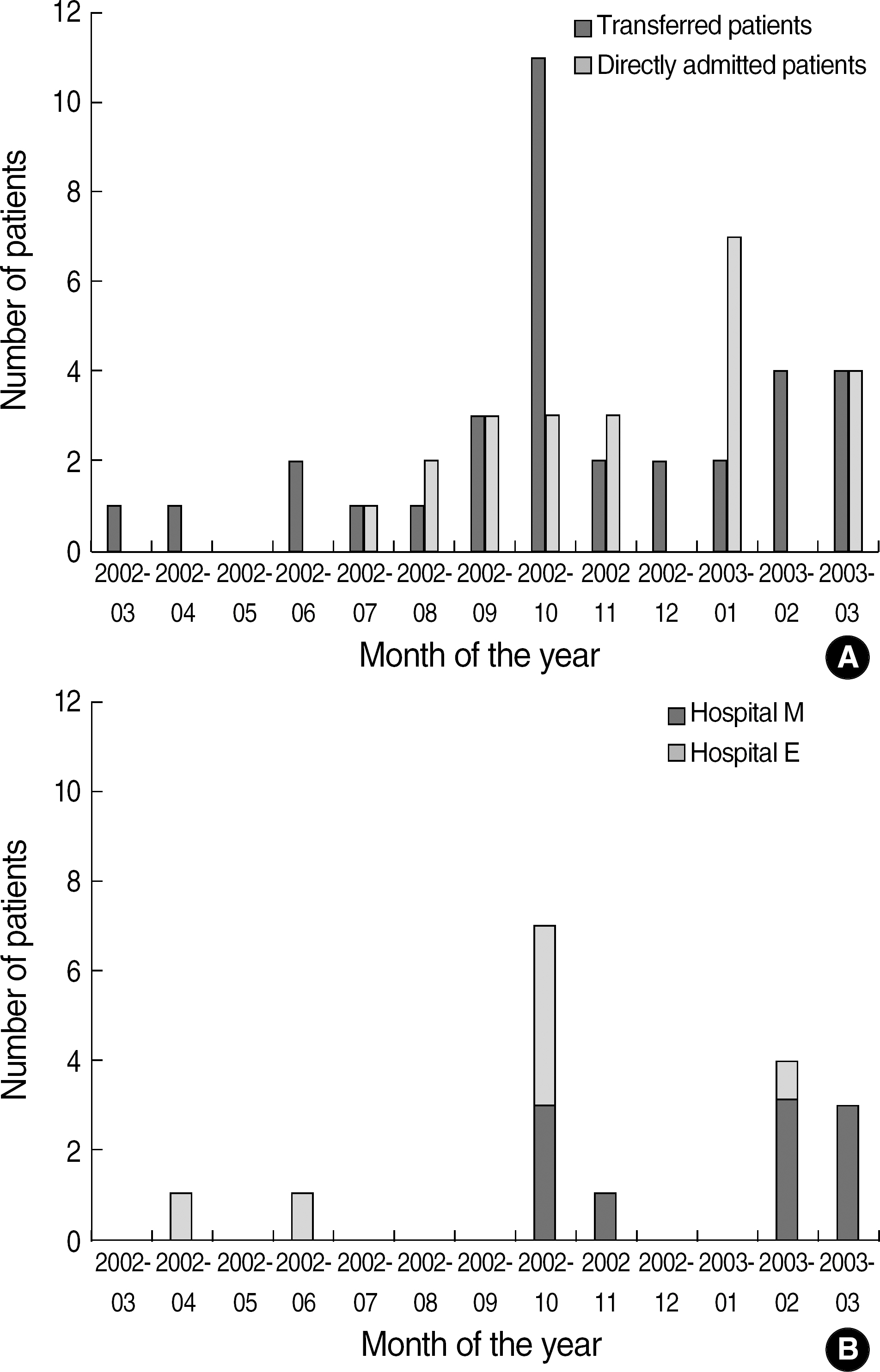Korean J Lab Med.
2006 Apr;26(2):86-92. 10.3343/kjlm.2006.26.2.86.
Comparison of Clinical Characteristics of Patients with Rotavirus Gastroenteritis Relative to the Infecting Rotavirus G-P Genotype
- Affiliations
-
- 1Department of Laboratory Medicine, Chosun University Medical School, Gwangju, Korea. dsmoon@chosun.ac.kr
- 2Research Center for Resistant Cells, Chosun University Medical School, Gwangju, Korea.
- 3Department of Laboratory Medicine, Hanyang University Guri Hospital, Guri, Korea.
- 4Department of Laboratory Medicine, Seonam University Medical School, Namwon, Korea.
- KMID: 2238896
- DOI: http://doi.org/10.3343/kjlm.2006.26.2.86
Abstract
-
BACKGROUND: Group A rotavirus is a major cause of severe diarrhea in children throughout the world. For the proper management of rotavirus infections, it will be helpful to know their clinical characteristics according to the G and P genotypes of the infecting virus.
METHODS
The diarrheal stool specimens from patients hospitalized in Chosun University Hospital during 2002-2003 were tested for rotavirus by Dipstick 'Eiken' Rota kit. Rotavirus antigen-positive stool specimens were analyzed for group A rotavirus by RT-PCR, and the group A-positive PCR products were genotyped for P and G types by PCR.
RESULTS
Among the 119 specimens analyzed for genotypes, the predominant strain was genotype G4P[6] (51.3%), followed by G2P[4] (19.3%), G1P[8] (7.6%), G3P[8] (5.0%), and G9P[8] (4.2%). To examine the characteristics of each rotavirus genotype, a clinico-epidemiological study was performed for 100 patients whose medical records were available. The frequencies of diarrhea, vomiting, dehydration, and fever; the rates of nosocomial infection and transfer from other hospitals; and the mean severity scores were significantly different among the patients infected with different types of rotavirus. Especially, patients with G4P[6] type were more likely than those infected with other genotypes to show the following distinct features: Most patients showed milder symptoms and were neonates transferred from other obstetric hospitals and 68.4% of the cases were nosocomial infection. G4P[6] strains were isolated almost all along the year. The mean severity scores of patients infected by G4P[6], G2P[4], G1P[8], G3P[8], and G9P[8] strains were 6.8, 9.5, 8.0, 9.0, and 10.8, respectively.
CONCLUSIONS
Many features of rotavirus infections including the epidemic period, rate of nosocomial infection, age and severity of symptoms were different according to the genotypes of the infecting virus.
MeSH Terms
Figure
Reference
-
References
1. Parashar UD, Hummelman EG, Bresee JS, Miller MA, Glass RI. Global illness and deaths caused by rotavirus disease in children. Emerg Infect Dis. 2003; 9:565–72.
Article2. Widdowson MA, van Doornum GJ, van der Poel WH, de Boer AS, Mahdi U, Koopmans M. Emerging group-A rotavirus and a nosocomial outbreak of diarrhoea. Lancet. 2000; 356:1161–2.
Article3. Kang JO, Kilgore P, Kim JS, Nyambat B, Kim J, Suh HS, et al. Molecular Epidemiological Profile of Rotavirus in South Korea, July 2002 through June 2003: Emergence of G4P[6] and G9P[8] Strains. J Infect Dis. 2005; 192(Suppl 1):S57–63.
Article4. Ruuska T, Vesikari T. Rotavirus disease in Finnish children: use of numerical scores for clinical severity of diarrhoeal episodes. Scand J Infect Dis. 1990; 22:259–67.
Article5. Dalton RM, Roman ER, Negredo AA, Wilhelmi ID, Glass RI, Sanchez-Fauquier A. Astrovirus acute gastroenteritis among children in Madrid, Spain. Pediatr Infect Dis J. 2002; 21:1038–41.
Article6. Santos N, Hoshino Y. Global distribution of rotavirus serotypes/genotypes and its implication for the development and implementation of an effective rotavirus vaccine. Rev Med Virol. 2005; 15:29–56.
Article7. Parashar UD, Bresee JS, Gentsch JR, Glass RI. Rotavirus. Emerg Infect Dis. 1998; 4:561–70.
Article8. Rahman M, Matthijnssens J, Goegebuer T, De Leener K, Vanderwegen L, van der Donck I, et al. Predominance of rotavirus G9 genotype in children hospitalized for rotavirus gastroenteritis in Belgium during 1999–2003. J Clin Virol. 2005; 33:1–6.
Article9. Castello AA, Arvay ML, Glass RI, Gentsch J. Rotavirus strain surveillance in Latin America: a review of the last nine years. Pediatr Infect Dis J. 2004; 23:S168–72.10. Iturriza-Gomara M, Green J, Brown DW, Ramsay M, Desselberger U, Gray JJ. Molecular epidemiology of human group A rotavirus infections in the United Kingdom between 1995 and 1998. J Clin Microbiol. 2000; 38:4394–401.
Article11. Iturriza-Gomara M, Isherwood B, Desselberger U, Gray J. Reassortment in vivo: driving force for diversity of human rotavirus strains isolated in the United Kingdom between 1995 and 1999. J Virol. 2001; 75:3696–705.
Article12. Seo JK, Sim JG. Overview of rotavirus infections in Korea. Pediatr Int. 2000; 42:406–10.
Article13. Mota-Hernandez F, Calva JJ, Gutierrez-Camacho C, Villa-Contreras S, Arias CF, Padilla-Noriega L, et al. Rotavirus diarrhea severity is related to the VP4 type in Mexican children. J Clin Microbiol. 2003; 41:315862.
Article14. Berner R, Schumacher RF, Hameister S, Forster J. Occurrence and impact of community-acquired and nosocomial rotavirus infections-a hospital-based study over 10 y. Acta Paediatr Suppl. 1999; 88:48–52.15. Kang JO, Kim MN, Kim J, Suh HS, Yoon Y, Jang S, et al. Epidemiologic Trends of Rotavirus Infection in the Republic of Korea, July 1999 through June 2002. Korean J Lab Med. 2003; 23:382–7.16. Widdowson MA, van Doornum GJ, van der Poel WH, de Boer AS, van de Heide R, Mahdi U, et al. An outbreak of diarrhea in a neonatal medium care unit caused by a novel strain of rotavirus: investigation using both epidemiologic and microbiological methods. Infect Control Hosp Epidemiol. 2002; 23:665–70.
Article17. Sermet-Gaudelus I, de La Rocque F, Salomon JL, Lachassine E, Leruez-Ville M, Baujat G, et al. [Rotavirus nosocomial infection in pediatric units. A multicentric observation study]. Pathol Biol (Paris). 2004; 52:4–10.





